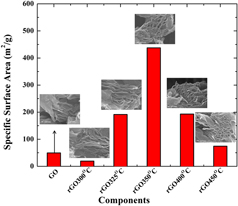Crossref Citations
This article has been cited by the following publications. This list is generated based on data provided by
Crossref.
Sengupta, Iman
Bhattacharya, Proma
Talukdar, Monikangkana
Neogi, Sudarsan
Pal, Surjya K.
and
Chakraborty, Sudipto
2019.
Bactericidal effect of graphene oxide and reduced graphene oxide: Influence of shape of bacteria.
Colloid and Interface Science Communications,
Vol. 28,
Issue. ,
p.
60.
Narayanan, Kannan Badri
Choi, Soon Mo
and
Han, Sung Soo
2019.
Biofabrication of Lysinibacillus sphaericus-reduced graphene oxide in three-dimensional polyacrylamide/carbon nanocomposite hydrogels for skin tissue engineering.
Colloids and Surfaces B: Biointerfaces,
Vol. 181,
Issue. ,
p.
539.
Raza, A.
Qumar, U.
Hassan, J.
Ikram, M.
Ul-Hamid, A.
Haider, J.
Imran, M.
and
Ali, S.
2020.
A comparative study of dirac 2D materials, TMDCs and 2D insulators with regard to their structures and photocatalytic/sonophotocatalytic behavior.
Applied Nanoscience,
Vol. 10,
Issue. 10,
p.
3875.
Santos, Patrícia F.
Ribeiro, Josimar
and
Luz, Priscilla P.
2020.
Physicochemical and electrochemical characterization of Ce/carbonaceous matrices-based composites.
Solid State Sciences,
Vol. 110,
Issue. ,
p.
106479.
Chen, Ya
Muthukumar, Kamalambika
Leban, Levon
and
Li, Jun
2020.
Microwave-assisted high-yield exfoliation of vanadium pentoxide nanoribbons for supercapacitor applications.
Electrochimica Acta,
Vol. 330,
Issue. ,
p.
135200.
Ramírez-Amador, R.
Alvarado, J.
Flores-Carrasco, G.
Morales-de la Garza, L.
Alcántara-Iniesta, S.
Luna-Flores, A.
Bernal, Y. P.
Méndez Rojas, Miguel Ángel
Gervacio-Arciniega, J. J.
Martínez Hernández, H. P.
Curioca-Vega, J. F.
and
Balcón-Camacho, J.
2020.
The Influence of Deposition Time on the Structural, Morphological, Optical and Electrical Properties of ZnO-rGO Nanocomposite Thin Films Grown in a Single Step by USP.
Crystals,
Vol. 10,
Issue. 2,
p.
73.
Henriques, Patrícia C.
Pereira, Andreia T.
Pires, Ana L.
Pereira, André M.
Magalhães, Fernão D.
and
Gonçalves, Inês C.
2020.
Graphene Surfaces Interaction with Proteins, Bacteria, Mammalian Cells, and Blood Constituents: The Impact of Graphene Platelet Oxidation and Thickness.
ACS Applied Materials & Interfaces,
Vol. 12,
Issue. 18,
p.
21020.
Narayanan, Kannan Badri
Kim, Hyun Duck
and
Han, Sung Soo
2020.
Biocompatibility and hemocompatibility of hydrothermally derived reduced graphene oxide using soluble starch as a reducing agent.
Colloids and Surfaces B: Biointerfaces,
Vol. 185,
Issue. ,
p.
110579.
Cutroneo, M.
Havranek, V.
Mackova, A.
Malinsky, P.
Torrisi, A.
Silipigni, L.
Sofer, Z.
and
Torrisi, L.
2020.
Selective modification of electrical insulator material by ion micro beam for the fabrication of circuit elements.
Radiation Effects and Defects in Solids,
Vol. 175,
Issue. 3-4,
p.
307.
Sengupta, Iman
Sharat Kumar, Suddhapalli S.S.
Pal, Surjya K.
and
Chakraborty, Sudipto
2020.
Characterization of structural transformation of graphene oxide to reduced graphene oxide during thermal annealing.
Journal of Materials Research,
Vol. 35,
Issue. 9,
p.
1197.
Silipigni, L.
Salvato, G.
Fazio, B.
Di Marco, G.
Proverbio, E.
Cutroneo, M.
Torrisi, A.
and
Torrisi, L.
2020.
Temperature and environment effects on the graphene oxide reduction via electrical conductivity studies.
Journal of Materials Science: Materials in Electronics,
Vol. 31,
Issue. 14,
p.
11847.
Latorrata, Saverio
Cristiani, Cinzia
Basso Peressut, Andrea
Brambilla, Luigi
Bellotto, Maurizio
Dotelli, Giovanni
Finocchio, Elisabetta
Gallo Stampino, Paola
and
Ramis, Gianguido
2020.
Reduced Graphene Oxide Membranes as Potential Self-Assembling Filter for Wastewater Treatment.
Minerals,
Vol. 11,
Issue. 1,
p.
15.
Karjule, Neeta
Barrio, Jesús
Xing, Lidan
Volokh, Michael
and
Shalom, Menny
2020.
Highly Efficient Polymeric Carbon Nitride Photoanode with Excellent Electron Diffusion Length and Hole Extraction Properties.
Nano Letters,
Vol. 20,
Issue. 6,
p.
4618.
Ikram, Muhammad
Raza, Ali
Imran, Muhammad
Ul-Hamid, Anwar
Shahbaz, Atif
and
Ali, Salamat
2020.
Hydrothermal Synthesis of Silver Decorated Reduced Graphene Oxide (rGO) Nanoflakes with Effective Photocatalytic Activity for Wastewater Treatment.
Nanoscale Research Letters,
Vol. 15,
Issue. 1,
Coros, Maria
Pogacean, Florina
Turza, Alexandru
Dan, Monica
Berghian-Grosan, Camelia
Pana, Ioan-Ovidiu
and
Pruneanu, Stela
2020.
Green synthesis, characterization and potential application of reduced graphene oxide.
Physica E: Low-dimensional Systems and Nanostructures,
Vol. 119,
Issue. ,
p.
113971.
Silva, Mariana R.F.
Lourenço, Mirtha A.O.
Tobaldi, David Maria
da Silva, Carla F.
Seabra, Maria Paula
and
Ferreira, Paula
2020.
Carbon-modified titanium oxide materials for photocatalytic water and air decontamination.
Chemical Engineering Journal,
Vol. 387,
Issue. ,
p.
124099.
Zhu, Tianyu
Wang, Yan
Li, Yang
Cai, Rui
Zhang, Jianfang
Yu, Cuiping
Wu, Jingjie
Cui, Jiewu
Zhang, Yong
Ajayan, Pulickel M.
and
Wu, Yucheng
2020.
CoO Quantum Dots Anchored on Reduced Graphene Oxide Aerogels for Lithium-Ion Storage.
ACS Applied Nano Materials,
Vol. 3,
Issue. 10,
p.
10369.
Singh, Sohan Bir
and
De, Mahuya
2020.
Thermally exfoliated graphene oxide for hydrogen storage.
Materials Chemistry and Physics,
Vol. 239,
Issue. ,
p.
122102.
Shen, Yue
Zhang, Shengdi
Sun, Yanxia
Hai, Chunxi
Li, Xiang
Zeng, Jinbo
Ren, Xiufeng
and
Zhou, Yuan
2020.
Structure and Property Evolution of Graphene Oxide Sheets during Low-Temperature Reduction on a Solid Substrate.
The Journal of Physical Chemistry C,
Vol. 124,
Issue. 26,
p.
14371.
OKUTAN, Merve
2020.
Termal indirgenmiş grafen oksit ile elektrokimyasal olarak askorbik asit tayini.
Gazi Üniversitesi Mühendislik Mimarlık Fakültesi Dergisi,
Vol. 35,
Issue. 3,
p.
1589.


